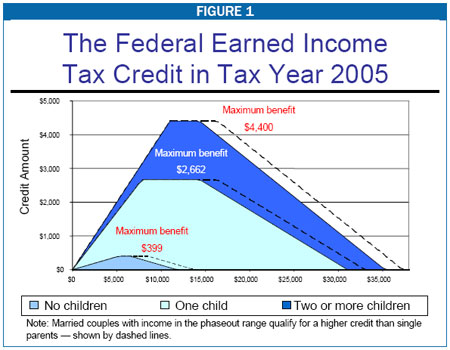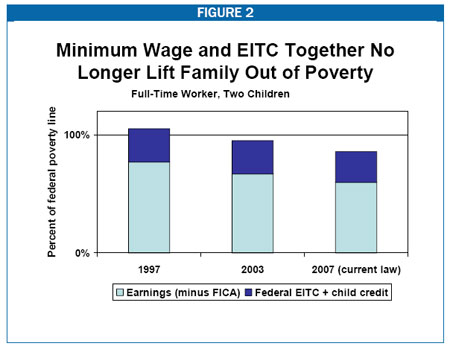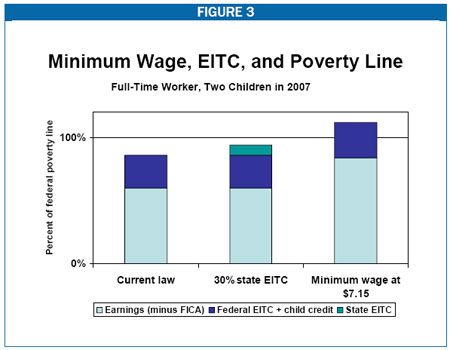|
March 22, 2006
TESTIMONY
BEFORE THE PENNSYLVANIA HOUSE OF REPRESENTATIVES FINANCE COMMITTEE ON STATE
EARNED INCOME TAX CREDITS
Nicholas Johnson, Director, State
Fiscal Project
Center on Budget and Policy Priorities
Chairman Leh, Chairman Levdansky and members of
the committee:
Thank you for the opportunity to testify today
about the Earned Income Tax Credit, or EITC. My name is Nicholas Johnson. I am
Director of the State Fiscal Project at the Center on Budget and Policy
Priorities. The Center is a non-profit, non-partisan research institute in
Washington. Our policy work addresses a range of government policies, with a
particular focus on their impacts on low- and moderate-income families. My work
for the last ten years has focused on state tax and budget policies. A major
area of concentration for me has been the design and implementation of state tax
policies that are targeted to poor families, particularly working-poor families.
My remarks today focus on three areas:
- I will describe the federal EITC and the state
EITCs that have been enacted in 19 states.
- I will explain how a Pennsylvania state EITC
might operate and who would benefit.
- I will place the possibility of a Pennsylvania
state EITC in the context of current discussions of an increase in the state
minimum wage.
Federal and State EITCs
The Earned Income Tax Credit addresses a
fundamental problem: many working families do not earn enough to live on.
Their wages are low and the costs of supporting a family — food, clothing,
housing, transportation, job-related costs, health care and so on — are
substantial. Some of those costs may be defrayed through various forms of
public programs. But most low-income families who are working receive only
limited help from public programs.
In Pennsylvania in 2003, there were about 163,000
working families with children whose incomes fell below the federal poverty
line. (The federal poverty line varies by family size and is adjusted each year
for inflation; in 2006 dollars, the poverty line for a family of four is roughly
$20,000.) Several hundred thousand more working families in Pennsylvania have
incomes slightly above the federal poverty line but still have difficulty making
ends meet.
One cost that low-income Pennsylvania families
face to a greater extent than families in other states is state and local
taxes. I should note that Pennsylvania no longer levies income tax on
low-income families, because of the “tax forgiveness” credit which is claimed on
Schedule SP of the Pennsylvania income tax form. This credit has been expanded
substantially since the mid-1990s; it now eliminates income tax liability for a
family of four with income up to $32,000.
However, Pennsylvania families – particularly
working families with relatively low incomes – pay substantial amounts of other
state and local taxes. These include general sales taxes, excise taxes,
property taxes, and local wage taxes, among others. The Institute on Taxation
and Economic Policy estimates that the lowest-income 20 percent of Pennsylvania
households in 2002 paid, on average, 11.4 percent of their incomes in state and
local taxes, a higher share than any other income group.

The Federal EITC
The Earned Income Tax Credit is a wage supplement
for low- and moderate-income working families, administered through the income
tax. The federal Earned Income Tax Credit was enacted in 1975, and major
expansions were enacted in 1986, 1990, and 1993. Today it is widely recognized
as the single most important public source of income support for working
families with children.
The EITC is available, by design, only to working
families. The maximum EITC benefit for the 2006 tax year is $4,520 for families
with two or more children and $2,737 for families with one child. The greater
EITC benefit for larger families reflects recognition that larger families face
higher living expenses than smaller families.
The EITC benefit that an eligible family receives
depends on the family’s income. For families with very low earnings, the value
of the EITC increases as earnings rise. A family with two or more children, for
example, receives an EITC equal to 40 cents for each dollar earned if their
earnings are $11,000 or less. The rate is slightly lower, 34 cents, for
one-child families. In this way, the EITC acts as a wage subsidy.
The maximum credit is available to single-parent
families with incomes up to $14,760, or two-parent families with incomes up to
$16,760. Above those income levels, the EITC gradually phases out, so that
families with incomes as high as $37,000 may receive some benefit from the
credit.
Workers without a qualifying child also may
receive an EITC, but the maximum credit for individuals or couples without
children is $411 in 2006, much lower than the credit for families with children,
and the income eligibility range is much smaller.
The effectiveness of the federal EITC both in
supporting work and in alleviating child poverty has been confirmed by a number
of recent studies.
- The EITC now lifts more than 4 million people
— roughly half of them children — out of poverty each year; it is the nation’s
most effective antipoverty program for working families.
- A substantial body of academic research now
shows that the credit has contributed to a significant increase in labor force
participation among single mothers.
- Interviews with EITC recipients show that many
use their EITC refunds to make the kinds of investments — paying off debt,
investing in education, securing decent housing — that enhance economic
security and promote economic opportunity.
State EITCs
Since the late 1980s, some 19 states have enacted
EITCs of their own. State EITCs have received broad support. EITCs have been
enacted in states led by Republicans, in states led by Democrats, and in states
with bipartisan leadership. The credits typically are supported by business
groups, social service advocates, faith-based groups, labor unions, and others.
State EITCs are very simple. They are nearly
always set at a flat percentage of the federal credit. In other words, a
family’s state EITC equals its federal credit multiplied by a given percentage
rate — for example, 30 percent in New York, 20 percent in New Jersey, 6 percent
in Indiana, 15 percent in Kansas. A New York family that receives a $3,000
federal EITC, for example, would qualify for a $900 New York State EITC.
|
TABLE 1: RECEIPT OF FEDERAL EITC
IN PENNSYLVANIA (TY2002) |
County |
Number of Tax Filers Receiving EITC |
Total EITC Amounts Received ($) |
County |
Number of Tax Filers Receiving EITC |
Total EITC Amounts Received ($) |
Adams |
4,708 |
7,357,774 |
Continued from previous column |
Allegheny |
67,613 |
105,396,379 |
Lackawanna |
12,477 |
19,652,328 |
Armstrong |
4,390 |
6,850,350 |
Lancaster |
23,672 |
38,317,465 |
Beaver |
9,942 |
15,373,804 |
Lawrence |
6,470 |
10,341,358 |
Bedford |
3,605 |
5,728,388 |
Lebanon |
6,755 |
10,713,828 |
Berks |
22,080 |
35,755,109 |
Lehigh |
18,554 |
31,163,838 |
Blair |
9,173 |
14,520,607 |
Luzerne |
18,535 |
28,937,675 |
Bradford |
4,631 |
7,459,643 |
Lycoming |
8,373 |
13,544,104 |
Bucks |
19,654 |
28,405,078 |
McKean |
3,128 |
5,182,892 |
Butler |
8,626 |
12,849,342 |
Mercer |
7,624 |
12,663,395 |
Cambria |
10,242 |
15,935,878 |
Mifflin |
2,996 |
4,606,777 |
Cameron |
407 |
659,060 |
Monroe |
8,448 |
13,792,214 |
Carbon |
3,711 |
5,874,061 |
Montgomery |
22,604 |
32,647,095 |
Centre |
5,100 |
7,385,921 |
Montour |
976 |
1,519,949 |
Chester |
12,656 |
18,842,811 |
Northampton |
14,205 |
22,599,474 |
Clarion |
2,570 |
3,942,024 |
Northumberland |
6,131 |
9,779,044 |
Clearfield |
5,938 |
9,226,476 |
Perry |
2,511 |
3,835,987 |
Clinton |
2,259 |
3,675,681 |
Philadelphia |
156,733 |
280,901,522 |
Columbia |
3,963 |
6,124,371 |
Pike |
2,256 |
3,774,596 |
Crawford |
6,178 |
10,033,961 |
Potter |
1,331 |
2,162,004 |
Cumberland |
8,366 |
12,436,617 |
Schuylkill |
8,758 |
13,265,045 |
Dauphin |
17,014 |
27,532,522 |
Snyder |
2,264 |
3,472,962 |
Delaware |
28,424 |
45,945,558 |
Somerset |
5,583 |
8,632,496 |
Elk |
1,900 |
2,761,754 |
Sullivan |
428 |
634,833 |
Erie |
20,584 |
34,426,825 |
Susquehanna |
3,099 |
5,128,733 |
Fayette |
11,962 |
19,855,856 |
Tioga |
3,249 |
5,448,765 |
Forest |
413 |
648,502 |
Union |
1,862 |
2,862,935 |
Franklin |
7,525 |
11,665,370 |
Venango |
4,104 |
6,665,931 |
Fulton |
1,036 |
1,507,073 |
Warren |
2,855 |
4,619,663 |
Greene |
2,917 |
4,916,657 |
Washington |
11,512 |
17,813,377 |
Huntingdon |
3,009 |
4,783,770 |
Wayne |
3,726 |
5,995,425 |
Indiana |
5,230 |
8,000,115 |
Westmoreland |
19,863 |
30,233,082 |
Jefferson |
3,376 |
5,319,284 |
Wyoming |
2,125 |
3,479,579 |
Juniata |
1,350 |
2,076,395 |
York |
21,359 |
33,985,583 |
|
|
|
All counties, total |
735,118 |
1,191,646,970 |
|
Source: The Brookings Institution,
Metropolitan Policy Program, Earned Income Tax Credit data from Internal
Revenue Service, TY2002; Center on Budget and Policy Priorities.
|
Because it is administered through the income
tax, compliance and administrative costs of the EITC are quite low.
Administrative costs for the federal EITC are less than 1 percent of total cost,
much lower than the costs of other federally funded income support programs such
as Food Stamps. For states, the administrative cost of an EITC is even lower
because the Internal Revenue Service does much of the work. For instance, the
federal government uses mechanisms such as large databases of social security
numbers to screen for ineligible EITC applicants and reject their claims.
States, in effect, piggyback on these federal enforcement mechanisms.
Fifteen of the existing 19 state EITCs follow
federal practice of offering credits that are refundable. This means a family
receives the full amount of its credit even if the credit amount is greater than
its income tax liability. The amount by which the credit exceeds annual income
taxes is paid as a refund. If a family has no income tax liability, the family
receives the entire EITC as a refund. This enables the EITC to operate as a
wage subsidy and an offset to all state and local taxes, not simply an offset to
state income tax liability.
Among Pennsylvania’s neighbors, New York, New
Jersey, and Maryland offer refundable EITCs, while Delaware offers a
non-refundable EITC. Among 20 Northeastern, Mid-Atlantic and Great Lakes
states, Pennsylvania is among only six that do not offer an EITC.
A Pennsylvania EITC
More than 700,000 Pennsylvania tax filers each
year benefit from the federal EITC and therefore would receive a Pennsylvania
EITC. Table 1 lists the number of Pennsylvania tax filers receiving the credit
by county.
|
TABLE 2: WHICH STATES HAVE EITCS AND/OR MINIMUM WAGE
HIGHER THAN FEDERAL? |
Both Minimum Wage Higher than Federal and State EITC |
Minimum Wage Higher than Federal Only |
State EITC Only |
Delaware |
Alaska |
Colorado* |
District of Columbia |
California |
Indiana |
Illinois |
Connecticut |
Iowa |
Maine |
Florida |
Kansas |
Maryland |
Hawaii |
Oklahoma |
Massachusetts |
Washington |
Virginia |
Minnesota |
|
|
New Jersey |
|
|
New York |
|
|
Oregon |
|
|
Rhode Island |
|
|
Vermont |
|
|
Wisconsin |
|
|
|
|
|
|
*Colorado EITC is presently
suspended.
Sources: U.S. Department of Labor, Employment
Standards
Administration, Wage and Hour Division; Center on
Budget and Policy Priorities
|
I noted earlier that Pennsylvania already offers
a tax credit, known as “tax forgiveness,” that eliminates income tax liability
for families with incomes below specific thresholds. Unlike the federal EITC
and most state EITCs, however, tax forgiveness is not refundable, and so it does
not function as a wage subsidy or offset other taxes. It merely eliminates
income tax liability, an important but limited feature. In addition, the top
income at which a family benefits from tax forgiveness tend to be slightly lower
than for the EITC. (Example: for a two-parent, two-child family, the income
cut-off is $34,250 for tax forgiveness but about $38,000 for the EITC.)
A Pennsylvania state EITC would augment the tax
forgiveness credit by providing a refund to many families with children.
For families that qualify for both full tax
forgiveness and the EITC, the EITC most likely would be structured as a refund
to be applied after tax forgiveness is applied to the income tax. Tax
forgiveness would eliminate income tax liability; the EITC then would provide a
refund.
For families for whom tax forgiveness reduces but
does not eliminate income tax liability, or for those who do not qualify for tax
forgiveness, the EITC would count against remaining tax liability.[1]
Pennsylvania
EITC refunds could be used to offset the burden of other state and local taxes,
such as sales, excise or property taxes, or to meet other costs associated with
working such as transportation, child care, and so on.

Taxpayers that do not qualify for an EITC, of
course, still would be fully eligible for tax forgiveness as under current law.
EITCs and the Minimum Wage
An Earned Income Tax Credit and a minimum wage
are complementary policies, not alternatives to each other.
At the federal level, at least until just a few
years ago, the EITC and the minimum wage worked together to lift families out of
poverty. As recently as 1997, a full-time, year-round job at the minimum wage,
combined with the federal EITC, was sufficient to lift a family’s after-tax
income above the federal poverty line for a family of three.
But with the erosion of the minimum wage over the
last eight years, it is no longer the case that a minimum-wage job lifts a
family out of poverty. Since 1997, the federal minimum wage has been frozen at
a nominal level of $5.15 per hour. In inflation-adjusted terms, it has
declined. (See Figure 2.)
A further problem is that a full-time worker at
the federal minimum wage with two or more children no longer earns enough to
qualify for the maximum EITC. This is because the parameters of the EITC are
indexed for inflation; the minimum wage is not.
As a result, the combined effect of net wages and
the EITC now fall substantially short of the federal poverty line for a family
of three.

A state EITC, by itself, does not solve this
fundamental problem caused by the eroding minimum wage. Figure 3 shows that
increasing the minimum wage to $7.15 per hour in 2007, as has been proposed,
would restore a full-time worker’s after-tax income to roughly what it was in
1997. A state EITC set at 30 percent of the federal EITC – which would be among
the nation's largest – by itself would go only about halfway to lifting income
above the poverty line.
In addition to providing different amounts of
benefits to a full-time minimum-wage worker, an EITC and an increased minimum
wage differ in other important ways.
A somewhat larger number of families benefit from
a state EITC than a minimum wage increase, for example. The Economic Policy
Institute estimates that a $7.25 minimum wage in 2004 would have aided some
366,000 Pennsylvania workers. This number is roughly half the number of tax
filers benefiting from an EITC.
The policies differ also in the types of families
that are helped the most. Minimum wage increases assist the lowest-wage
workers regardless of family structure. An EITC almost exclusively benefits
families with children.
Another difference between the policies is that a
state EITC is paid in a lump sum at the end of the year, when families file
their tax returns. The benefits of minimum wage increases show up directly in
families’ paychecks and can be used to pay bills throughout the year.
One reasonable strategy pursued by many states is
to enact both a minimum wage increase and a state EITC. Thirteen states –
including a majority of Northeastern, Mid-Atlantic and Great Lakes states – now
have both a state EITC and a state minimum wage above the federal minimum. In
fact, the number of states nationwide that have enacted both policies is greater
than the number of states that have adopted only one or the other.
The increasingly widespread embrace of both EITCs
and increased minimum wages suggests growing consensus that making work pay for
low-income families should not be the responsibility of the private sector
alone, nor the responsibility of the public sector alone. Rather, lifting
working families out of poverty and toward the middle class should be a shared
responsibility of employers, the government, and — of course — the working
families themselves.
To conclude, the Earned Income Tax Credit is an
administratively straightforward mechanism that has proven successful in
supporting work and lifting low-income working families out of poverty. I
welcome your questions.
End Note:
[1] An alternative approach would provide a state EITC benefit
only to the extent that the benefit exceeds a family’s tax forgiveness. This
would reduce the EITC’s benefit for most families as well as the overall fiscal
cost to the state. |

